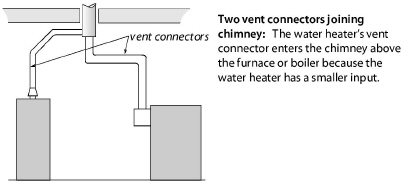
8.10 Inspecting Venting Systems
Combustion gases are vented through vertical chimneys or other types of approved horizontal or vertical vent piping. Identifying the type of existing venting material, verifying the correct size of vent piping, and making sure the venting conforms to the applicable codes are important tasks in inspecting and repairing venting systems. Too large a vent often leads to condensation and corrosion. Too small a vent can result in spillage. The wrong vent materials can corrode or deteriorate from heat.
The National Fire Protection Association (NFPA) publishes authoritative information on material-choice, sizing, and clearances for chimneys and vent connectors, as well as for combustion air. The information in this venting section is based on the following NFPA documents.
• NFPA 54: The National Fuel Gas Code
• NFPA 31: Standard for the Installation of Oil-Burning Equipment
• NFPA 211: Standard for Chimneys, Fireplaces, Vents, and Solid-Fuel-Burning Appliances
A vent connector connects the wood stove’s vent collar with the chimney. Approved vent connectors for gas-fired units are made from the following materials.
• Type-B vent, consisting of a galvanized steel outer pipe and aluminum inner pipe for gas-fired units.
• Type-L vent connector with a stainless-steel inner pipe and a galvanized-steel outer pipe for oil-fired units.
• Double-wall stove-pipe vent connector with a stainless-steel inner pipe and a black-steel outer pipe for solid-fuel units.
• Galvanized steel pipe for gas or oil-fired units only: See table.
|
Inches (gauge) |
|
|---|---|
|
5 and smaller |
0.022 (26 gauge) |
|
6 to 10 |
0.028 (24 gauge) |
|
11 to 16 |
0.034 (22 gauge) |
|
Larger than 16 |
0.064 (16 gauge) |
|
From International Mechanical Code 2009 |
|
Double-wall vent connectors are the best option, especially for appliances with some non-vertical vent piping. A double-wall vent connector maintains a sufficient flue gas temperature and prevents condensation.
Anywhere that draft is weak or flue gas temperature is low, use a double-wall vent connector. Gas appliances with draft hoods installed in attics or crawl spaces must use a Type-B vent connector. Use Type-L double-wall vent pipe for oil vent connectors in attics and crawl spaces.
Vent-Connector Requirements
Verify that vent connectors comply with these specifications.
• Vent connectors must be as large as the vent collar on the appliances they vent.
• Single wall vent-pipe sections must be fastened together with 3 screws or rivets at each joint.
• Vent connectors must be sealed tightly where they enter masonry chimneys.
• Vent connectors must be free of rust, corrosion, and holes.
• Maintain minimum clearances between vent connectors and combustibles.
• The chimney combining two draft-hood vent connectors must have a cross-sectional area equal to the area of the larger vent connector plus half the area of the smaller vent connector. This common vent must be no larger than 7 times the area of the smallest vent connector. For specific vent sizes, see the NFPA codes listed on page 307.
|
Vent diameter |
4" |
5" |
6" |
7" |
8" |
|
Vent area (square inches) |
12.6 |
19.6 |
28.3 |
38.5 |
50.2 |
• The horizontal length of vent connectors shouldn’t be more than 75% of the chimney’s vertical height or have more than 18 inches horizontal run per inch of vent diameter.
• Vent connectors must have upward slope to their connection with the chimney. NFPA 54 requires a slope of at least 1/4-inch of rise per foot of horizontal run so that combustion gases rise through the vent. The slope also prevents condensation from collecting in the vent and corroding it.
|
Diam (in) |
3" |
4" |
5" |
6" |
7" |
8" |
9" |
10" |
12" |
14" |
|
Length (ft) |
4.5' |
6' |
7.5' |
9' |
10.5' |
12' |
13.5' |
15' |
18' |
21' |
|
From International Fuel Gas Code 2000 |
||||||||||
• When two vent connectors connect to a single chimney, the vent connector servicing the smaller appliance must enter the chimney above the vent for the larger appliance.
